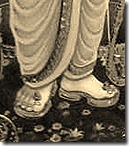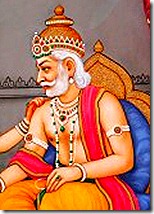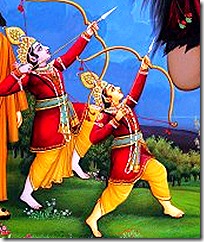 “Always chanting My glories, endeavoring with great determination, bowing down before Me, these great souls perpetually worship Me with devotion.” (Lord Krishna, Bhagavad-gita, 9.14)
“Always chanting My glories, endeavoring with great determination, bowing down before Me, these great souls perpetually worship Me with devotion.” (Lord Krishna, Bhagavad-gita, 9.14)
The sun is such a central component of life on earth that man revolves his routine around its relative position. The demarcation of a day is based on the full cycle of a rise and set by the sun, and with that day comes the routine of work, leisure, play, interaction, travel, rest, eating, etc. Yet man doesn’t have to do things this way. After waking up in the morning, he could just continue on from the previous day, as if no time had passed, as if the calendar hadn’t rolled onto another day. The routine, though, brings regulation, and regulation brings the ability to achieve a larger stated objective through a methodical process. When that same methodology is applied to fulfilling life’s ultimate mission, that of achieving the perfect consciousness while quitting the body, the rising and setting of the sun turn into welcomed and anticipated events.
 Imagine seeing a giant housing structure full of intricacy. There are many floors and rooms, and the layout is such that you can’t begin to imagine how someone thought up the architecture. But someone did indeed envision the plan, which they subsequently put into place through the work of engineers and builders. As they say, “Rome wasn’t built in a day”, the project takes dedication and effort through many days, building little pieces here and there. In one way, forgetting about the big picture can be helpful, for by giving attention to tiny components that should fit perfectly well together, the mind doesn’t get overwhelmed about the length of the project. If someone were to tell us during youth that school would take twelve years to complete and we knew what that meant, we’d likely not want to attend.
Imagine seeing a giant housing structure full of intricacy. There are many floors and rooms, and the layout is such that you can’t begin to imagine how someone thought up the architecture. But someone did indeed envision the plan, which they subsequently put into place through the work of engineers and builders. As they say, “Rome wasn’t built in a day”, the project takes dedication and effort through many days, building little pieces here and there. In one way, forgetting about the big picture can be helpful, for by giving attention to tiny components that should fit perfectly well together, the mind doesn’t get overwhelmed about the length of the project. If someone were to tell us during youth that school would take twelve years to complete and we knew what that meant, we’d likely not want to attend.
Instead, we take one year at a time, focusing on advancing to the next grade. The same pattern is followed in any large scale project. In software application development, there are many complexities that need to be worked out. The enterprise application isn’t built in a day, but through building a solid codebase, adding routines, testing them, redesigning for efficiency and then retesting, eventually a solid program is completed.
According to the Vedas, the oldest scriptural tradition of the world, there is an Absolute Truth, an entity who is beyond duality. The world we live in is filled with polar opposites: heat and cold, light and darkness, success and failure, and birth and death. The Absolute Truth is the entity that is above these dichotomies. He is the same in birth and death, in heat and cold. The relative conditions don’t matter to Him because He is situated in complete knowledge and bliss. As His existence stretches the bounds of time and space, He is eternal.
The human form of body is meant for understanding that Absolute Truth. Indeed, the search for pleasure is rooted in the desire to associate with non-duality, though the feverish worker may not be aware of this fact. The bliss resulting from innovation in technology, from finishing a difficult project, or even from enjoying with friends and family is derived from the inherent relationship every living being has with the Absolute Truth.
The questions remain: how to connect with the Truth and where to find Him? How do we know that the Truth is a He? Doesn’t the masculine delineation make the Truth the opposite of something else, namely the feminine? If we have an opposite, isn’t that a duality? The Absolute Truth is referred to as a male because of its position of dominance. Mutually contradictory attributes must exist in the Supreme Person; otherwise the lack of features would indicate a defect. Man is looking for perfection in a worshipable figure, someone without defects. The daily stories in the news reveal this inner desire of man. A noted inventor, technologist, politician, athlete, or celebrity is propped up to “rock star” status and adored for their achievements. If they should fall, have a slip up, the same adoring media will punish them relentlessly, looking for any way possible to release their hatred.
The perfect being is known as God to most, but the Vedas provide many more names and descriptions for Him. Moreover, the Vedas say that the human brain cannot conceive of God on its own. Man must consult someone who knows the Truth from having both accepted the information from their own spiritual guide and from practicing the regulative principles of freedom. The highest form of religious practice is equated with freedom because through connection with the Absolute Truth, the duality of the phenomenal world ceases to be inhibiting. The sunlight shining bright in the eyes in the morning inhibits the ability to drive and to see what’s up ahead, but this doesn’t mean that the sunshine is bad. It all depends on how one uses the material elements. Through following the regulative principles of freedom, the material elements fulfill their proper purpose to the individual.
“One who can control his senses by practicing the regulated principles of freedom can obtain the complete mercy of the Lord and thus become free from all attachment and aversion.” (Lord Krishna, Bhagavad-gita, 2.64)
 And what purpose is that? Not surprisingly, it is to help the individual connect with God. The bona fide guru learned from his guru the principles of bhakti-yoga, or devotional service
And what purpose is that? Not surprisingly, it is to help the individual connect with God. The bona fide guru learned from his guru the principles of bhakti-yoga, or devotional service
In bhakti practiced in a land conducive to illusion, the distractions are everywhere. The spirit soul has travelled through so many bodies in so many lifetimes that understanding the need for self-realization is rare enough. One who strives for understanding the position of the spirit soul, the essence of identity, is considered very fortunate. Once the sincere soul hears about the Absolute Truth and what’s required to connect with Him, they may accept the bhakti discipline in earnest, but the same past habits borne of attachment to use material elements for enjoyment in the absence of God’s association will still remain.
“After many births and deaths, he who is actually in knowledge surrenders unto Me, knowing Me to be the cause of all causes and all that is. Such a great soul is very rare.” (Lord Krishna, Bg. 7.19)
In the pursuit for self-realization, for understanding the individual’s identity and how one is meant to be in God’s association, the repetition of days can be very helpful. In a life where one feels trapped, as if they are in a prison, the monotonous days can be too much to take. With the start of each new week, you have to go back to work, immerse yourself in the same arduous tasks from the previous week. The same goes for each new day. You have to shower, eat on time, do your chores, manage the home, keep family members happy, and follow so many other routine engagements just because another day has passed. The weekends and vacations are anticipated for the very reason that time loses its influence. The more the human mind can forget about the pressures that time brings, the more relaxed it will feel.
 In bhakti, however, routine things that are monotonous can be turned around into pleasurable dependencies. The passage of time, the repetition of days, suddenly becomes a wonderful boon. The central component of the bhakti-yoga discipline is the chanting
In bhakti, however, routine things that are monotonous can be turned around into pleasurable dependencies. The passage of time, the repetition of days, suddenly becomes a wonderful boon. The central component of the bhakti-yoga discipline is the chanting
But what if we didn’t have that routine, which is built on the passage of time as marked by the relative position of the sun? The opportunity for repeatedly reciting the holy name would go away. The chance to hear the sound of Krishna, which brings to mind the sweet vision of the Supreme Personality of Godhead smiling while holding His flute and giving that innocent glance that is both charming and inviting, would be missed. The most wonderful vision of the Supreme Lord in His form as Rama, holding a bow in His hands and waiting to defend and protect the innocent, receiving the service of Shri Hanuman
Chanting is the foundation stone of bhakti-yoga, and it is meant to act as a springboard. From chanting comes hearing. From hearing comes the accumulation of thoughts, ideas for new ways to potentially connect with Krishna, the Supreme Absolute Truth. With other activities, such as visiting a temple, reading a book about Krishna, cooking nice food preparations and offering them to the Lord to become prasadam
From following a routine, habits develop. It is said that the habits one develops before they reach the age of thirty shape their behavior for the rest of their life. Therefore in the Vedic tradition, students are introduced to Krishna-bhakti as early as possible. There are other methods of self-realization, such as meditation, study of Vedanta, and fruitive work with the results renounced, but they each carry prerequisites. To meditate requires ideal conditions of peace and quiet, Vedanta study demands high intelligence, and fruitive work with detachment depends on knowledge of the impact of the work and the ability to carry out the functions properly.
 All bhakti requires, however, is love. This love can be seen in even the child, so someone immature can take to chanting and dancing and be immersed in yoga. The aspect of spirituality that is applicable to the most number of people will be the best, and it will have God represented most fully. The holy name is non-different from Krishna, a truth proved by the fact that anyone can recite the holy name, even if they are unintelligent or unfamiliar with the principles of Vedic teachings.
All bhakti requires, however, is love. This love can be seen in even the child, so someone immature can take to chanting and dancing and be immersed in yoga. The aspect of spirituality that is applicable to the most number of people will be the best, and it will have God represented most fully. The holy name is non-different from Krishna, a truth proved by the fact that anyone can recite the holy name, even if they are unintelligent or unfamiliar with the principles of Vedic teachings.
From following bhakti, the dawn of each new day brings renewed hope, a chance to connect with Krishna again. The new day arrives without our desiring it, so this means that we will continue to get new opportunities in bhakti for as long as we shall so desire them. Just as the lotus flower opens at the sight of the splendorous sun, the sincere servant of the Supreme Lord wakes up every day with bright enthusiasm over their chance to tell their beloved just how much they love Him. At the end of life, that spiritual sunshine is met in His permanent home, with life’s mission fulfilled.
In Closing:
At rising of the bright sun we are glad,
But to repeat misery we are sad.
To man the sun is giver of light and heat,
But each day chores and tasks we must repeat.
Use the passing of days for your benefit,
So that best end you’ll meet after body to quit.
Daily chant maha-mantra rounds that are sixteen,
So that in your mind’s vision Krishna to be seen.
Take every day as giver of chance that is new,
To please the Lord of complexion dark blue.
 “O Prabhu, you fulfill all desires and give the four fruits of existence. Understanding that, I am fearful of what I could possibly give to you.” (Janaki Mangala, 22)
“O Prabhu, you fulfill all desires and give the four fruits of existence. Understanding that, I am fearful of what I could possibly give to you.” (Janaki Mangala, 22) With that firm authority came great responsibility. King Dasharatha and those rulers appearing before him in the family upheld virtue. Maharaja Ikshvaku set the standard for good governance, having heard the truths of the Bhagavad-gita from his father Manu. Manu heard it from Vivasvan, who heard it from Shri Krishna, the original speaker of the Gita. The Bhagavad-gita is a song containing the essence of Vedic teachings, the true meaning of life and the ultimate philosophy to guide mankind’s behavior.
With that firm authority came great responsibility. King Dasharatha and those rulers appearing before him in the family upheld virtue. Maharaja Ikshvaku set the standard for good governance, having heard the truths of the Bhagavad-gita from his father Manu. Manu heard it from Vivasvan, who heard it from Shri Krishna, the original speaker of the Gita. The Bhagavad-gita is a song containing the essence of Vedic teachings, the true meaning of life and the ultimate philosophy to guide mankind’s behavior. A king like Dasharatha knew the governing principles, how to guide human behavior properly. Freedom is wonderful, but if it is misused you get chaos and misery. A document only limiting the actions of government will not provide man the guidance that he so desperately wants. History is filled with tyrannical regimes who killed millions of people to meet the demands of their brutal leaders. This could only occur because of the soul’s inclination to serve. Even with full freedom, with no restrictions on action, the living being will have a desire to offer some service.
A king like Dasharatha knew the governing principles, how to guide human behavior properly. Freedom is wonderful, but if it is misused you get chaos and misery. A document only limiting the actions of government will not provide man the guidance that he so desperately wants. History is filled with tyrannical regimes who killed millions of people to meet the demands of their brutal leaders. This could only occur because of the soul’s inclination to serve. Even with full freedom, with no restrictions on action, the living being will have a desire to offer some service. Rama was Dasharatha’s most prized possession, his favorite person in the world. The king would have to agree to the sage’s request though, so Rama went with Vishvamitra, with Rama’s younger brother
Rama was Dasharatha’s most prized possession, his favorite person in the world. The king would have to agree to the sage’s request though, so Rama went with Vishvamitra, with Rama’s younger brother